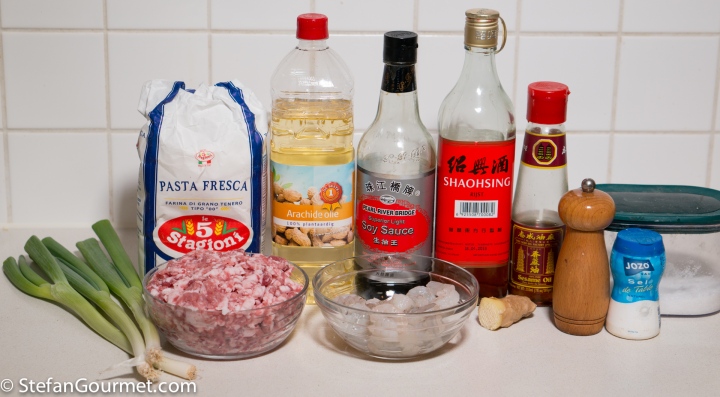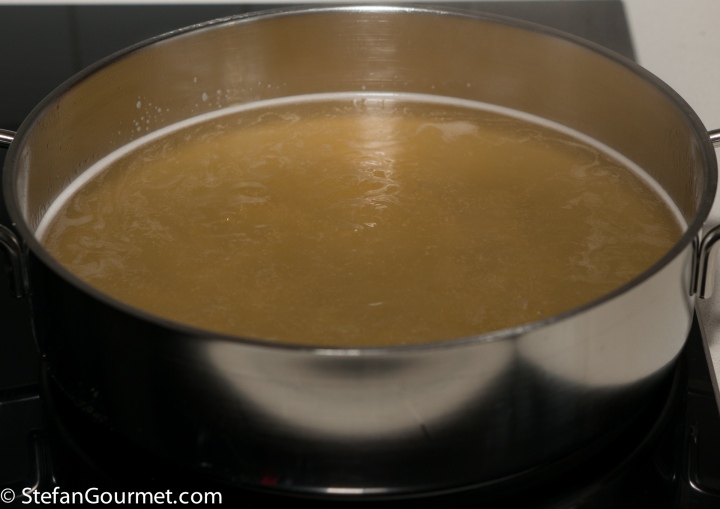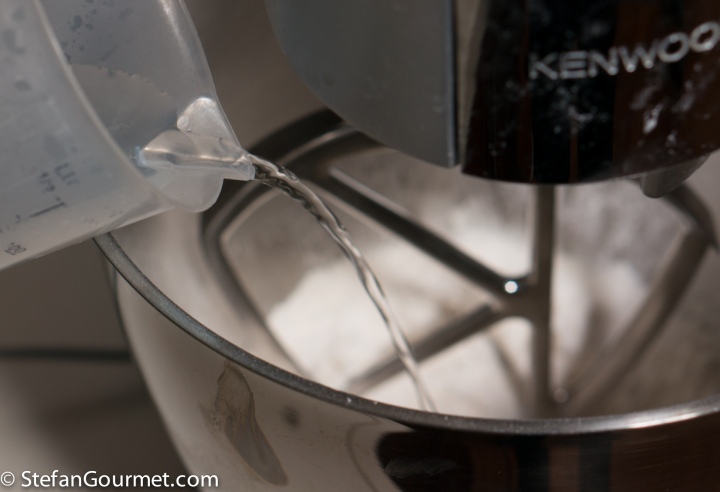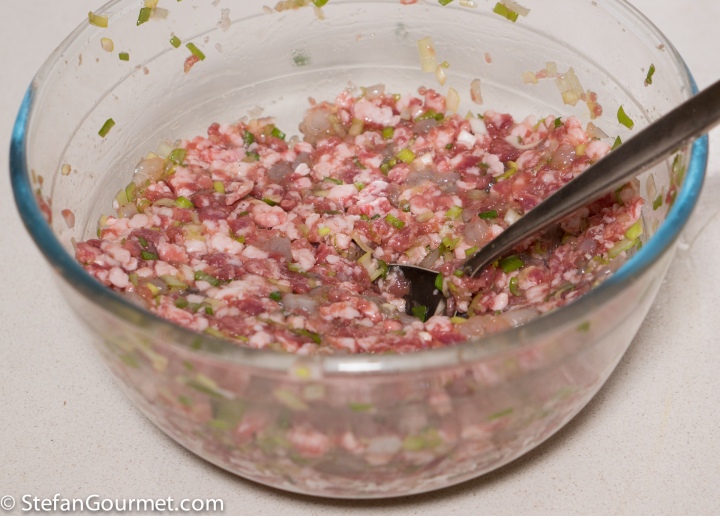This is the first of a series of dishes that we really enjoyed in Taiwan and I wanted to recreate at home: dumplings that have soup in them, that will burst open in your mouth as you eat them. They are quite a bit of work to make, but oh so worth it. The trick to getting the soup inside the dumpling is to make pork stock with plenty of gelatin and then cool it until it sets. The stock is now solid and can be added to the filling of the dumplings. When the dumpling is steamed, the soup will become liquid again. We had these a couple of times in Taiwan, and loved them every time. This homemade version is at least as good.
I’ve used some online recipes for inspiration, but all of them depend on adding gelatin to the soup. By using pork trotters, there will be plenty of gelatin in the soup, so there is no need to add powdered gelatin. It is best to make the soup the day before, so you can allow it to cool and remove the fat that will float on top before reducing the soup to concentrate the flavor.
Ingredients
Makes about 48 dumplings
For the soup
2 pork trotters
600 grams (1.3 lb) ground pork
50 grams (1.8 oz) cured ham, chopped
2 green onions, chopped
1/2 tsp white peppercorns
3 slices of ginger (about 3 mm or 1/8 inch thick)
1/2 tsp fresh ginger juice
2 tsp shaoxing rice wine
salt and freshly ground white pepper
For the filling
450 grams (1 lb) ground pork
150 grams (.33 lb) shrimp (peeled and deveined), minced
3 green onions, minced
1 tsp sugar
3/4 tsp salt
2 Tbsp soy sauce
1/4 tsp freshly ground white pepper
1/2 tsp freshly grated ginger
1 tsp shaoxing rice wine
1/4 tsp sesame oil
For the dough
400 grams (2 2/3 cups) flour, I used Italian 00 flour
180 ml (3/4 cup) boiling water
60 ml (1/4 cup) cold water
1 Tbsp vegetable oil
For the dipping sauce
60 ml (4 Tbsp) light soy sauce
60 ml (4 Tbsp) black vinegar
5 cm (2″) ginger, peeled and thinly sliced
1 tsp sesame oil
To steam
Chinese cabbage (Napa cabbage) leaves
Instructions
Put the pork trotters, ground pork for the soup, cured ham, green onions, white peppercorns, and ginger in a stockpot or pressure cooker. Cover with water, about 1.5 litres (6 cups). Simmer for 4 hours or pressure cook for 2 hours.
Sieve the stock with a fine sieve.
Allow the stock to cool completely and then refrigerate overnight.
The next day, the fat that floats on top can be removed easily. Save it for another use — it is excellent to pan fry pork for other recipes.
I made this photo just to show you that the stock contains plenty of gelatin.
Put the stock in a wide pan, bring it to a boil, then reduce over medium heat to about 360 ml (1 1/2 cups).
Add 2 teaspoons of shaoxing rice wine and briefly allow the alcohol to evaporate, then turn off the heat. Add 1/2 teaspoon of fresh ginger juice. (You can make ginger juice by grating ginger and then pressing down on it with a spoon.) Taste and adjust the seasoning with salt and freshly ground white pepper.
Pour the stock into a dish and allow it to set (first allow to cool to room temperature, then refrigerate). The concentrated stock will become VERY solid.
To make the dough, put the flour in the bowl of a stand mixer fitted with the paddle attachment. Add 180 ml of boiling water with the machine running.
Mix until the dough is a crumbly mess.
Now, with the motor still running, add just enough cold water, about 60 ml or 1/4 cup, to allow the dough to come together.
Add a tablespoon of vegetable oil.
Switch over to the dough hook, and knead until the dough is smooth and elastic, about 5 minutes.
Wrap the dough in plastic film and allow to rest for about 1 hour.
Meanwhile, prepare the filling. Start by mincing the shrimp.
For the ground pork in the dumplings I used the neck of iberico pork (a Spanish breed used to make the famous jamón iberico) and ground it myself.
Mix the minced shrimp with the ground pork, minced green onions, sugar, salt, soy sauce, white pepper, grated ginger, shaoxing rice wine, and sesame oil. Stir well.
Dice the gelatinized soup. Many recipes tell you to mix this into the filling…
…and that is what I did. With hindsight I think it is better for an equal distribution of the soup to keep the diced soup separate, and add some pieces to each dumpling.
The traditional way is to roll out individual round sheets of dough that are thicker in the center than at the edges. I took a shortcut and used my pasta maker to roll out the dough to the thinnest setting and then use a 10 cm (4″) cookie cutter to cut out circles of dough. Gather the trimmings and combine them with the remaining dough.
Put a tablespoon of filling on the center of each piece of dough. If you work quickly, there is no need to moisten the edge of the dough.
Close each dumpling by ‘pleating’ them. Arrange them on a floured surface. The dumplings can be refrigerated until later.
Cover the bottom of a steaming basket with a single layer of Chinese cabbage. Put this over simmering water for about 2 minutes to soften the cabbage and heat up the steamer.
Arrange the dumplings on top of the cabbage, making sure to leave at least 1 cm (1/2 inch) between them. The dumplings will expand sideways a little, and you don’t want them to end up touching as they may rupture as you take them out, spilling the soup inside. Steam the dumplings for about 12 minutes.
Meanwhile, make the dipping sauce by mixing black vinegar, soy sauce, ginger, and sesame oil.
The dumplings are done when you can see the filling through the dough. Serve them at once, but warn your guests that the soup inside may be hot. Some people say to slurp out the soup first, but I think it is much more spectacular to feel the soup burst in your mouth.
Wine pairing
Restaurants in Taiwan generally do not sell wine. But back home I enjoyed a very nice Godello from Valdeorras (in Spain) with these dumplings.
Flashback
Pork with almonds and paprika is a very nice dish that looks great, too. When I prepared this two years ago, I used the same type of Iberico pork that I used to fill today’s dumplings.































Some of these ‘little dragon buns’ are huge … several inches across.. and they take a lot of dexterity to eat. Also… dried shrimp in the pork mix is wonderful too!
LikeLiked by 1 person
You rock! 🌟✨💫 That sounds very challenging, that’s for sure.
LikeLiked by 1 person
I love them and prep them often at home 🙂
Cheers !
LikeLiked by 1 person
Nice work. I like that you made the dumpling wrapper too. I frequently go the lazier route and buy the wrappers from a Chinese grocery store when making dumplings.
LikeLiked by 1 person
Oh Stefan – I tend to burn my mouth when I eat these little darlings, but shall follow your way 🙂 ! Quite some work but worth it . . . I really must put cabbage leaves at the bottom of the steamer . . . . just ‘back’ from John’s: softly laughing at your thoughts re us Aussies mixing all of Asia up: guess you are right but as we generally do not put generic names on our offerings – what tastes good . . .
LikeLiked by 1 person
LOL I was wondering if you’d pick up on that. You are right about the names, but that doesn’t mean it’s a good idea to put cilantro and Sriracha on everything.
LikeLiked by 1 person
These sound fantastic! Never had a dumpling with a bite if soup in it before. Delish!
LikeLiked by 1 person
Mmmmmmmm dim sum
LikeLiked by 1 person
I tasted similar in 1975 when I ordered a Shrimp Wonton soup in Vancouver, BC. The broth was tasty and savory but nothing out of the ordinary, until I bit into my first wonton!
It exploded in my mouth with Shrimp flavour that i never experienced again, anywhere.
So I tried my own about 6/7 years ago and gelatinized a shrimp stock to add to my 2 : 1 shrimp to pork filling ! ! !
To THE Moon!
LikeLiked by 1 person
That sounds like a great idea!
LikeLiked by 1 person
Loved the recipe
LikeLiked by 1 person
Very detailed recipe. Sounds like a flavour explosion.
LikeLiked by 1 person
Well, ok, I think it’s faster for me to fly to your home, taste them and fly back to Italy 😉
LikeLiked by 1 person
Let me know and I’ll have them ready for you. Using the pork trotters (feet) is very “you” 🙂
LikeLiked by 1 person
Thank you Stefan. Sono sicura che lo prepareresti davvero
LikeLiked by 1 person
I’ll join Paola… this recipe sounds scrumptious but I will need a lot of free time before to try them… maybe when all my daughters will attend school, I will give it a try 😉!
LikeLiked by 1 person
If I wanted to add wasabi to the dough to make this more of a wasabi shu mai type of recipe, do you have any idea how much I’d use? I have searched in vain for a wasabi shu mai recipe online. Thanks, excited to try this.
LikeLike
There is a reason there is no online recipe and that is that there is no such thing as wasabi shu mai in China or Taiwan, wasabi being Japanese. You would have to use a lot: I read somewhere that someone tried this with a whole tin of wasabi powder to 4 cups of flour and it was still too subtle. If you’re looking for heat, you could just sprinkle the shu mai with chilli powder.
LikeLike
Here in America wasabi shu mai is available in many sushi restaurants, and oh-my-god is it good. It is essentially a steamed dumpling, but the wrapper is green, ostensibly from the wasabi. They are not overly hot, but combined with the flavor of the filling, so good. I will ask a sushi chef about it next time I’m out, many thanks for your response.
Enjoying your blog, cheers!
LikeLiked by 1 person
I do admire your willingness to make these effortful beauties at home.
LikeLiked by 1 person